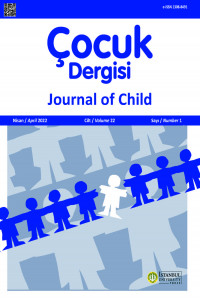Abstract
Makrosefalinin en sık sebeplerinden biri olan benign infantil hidrosefali, beyin omurilik sıvısının emiliminden sorumlu araknoid villusun olgunlaşmamasından kaynaklandığı düşünülen kendini sınırlayan bir klinik durumdur. Baş çevresinin normalin üzerinde olması ve geniş ön fontanel bulguları olan vakaların zamanla araknoid villusların olgunlaşması ile beyin omurilik sıvısının emilimi normale döner ve 18-24 ay civarında bulgular gerilemeye başlar. Hastalık nörolojik açıdan herhangi bir sekel bırakmadan kendiliğinden düzelir. Bu nedenle, baş çevresinde artış olması çocuğu takip eden hekim ve ebeveynlerde anksiyeteye neden olsa da, sadece mental motor gelişmenin geri kaldığı veya 2 yaşına kadar subaraknoid boşluktaki genişlemenin düzelmediği çocuklarda ileri tetkik yapılmalıdır. Bu olguyu sunmaktaki amacımız; makrosefali saptanan çocuklarda “benign infantil hidrosefali” düşünülüyorsa ve nörolojik muayene normal, nörogelişimsel geriliği yok ise, çocuğu yakın takibin yeterli olacağını, ileri incelemelerin yapılmasının gerekli olmadığını vurgulamaktır. Olgumuz; doğumda ve ilk üç ayda baş çevresi normal sınırlarda seyreden, daha sonraki izlemlerinde hızla artarak >97 persentil’e çıkan bir hastadır. Yapılan tetkikleri sonucu benign infantil hidrosefali olarak değerlendirilmiştir.
Keywords
Supporting Institution
yok
References
- 1. Sverre MZ, Arild E, Eirik H, Knut W. Benign external hydrocephalus: A review, with emphasis on management. Neurosurgery 2011;34:417-32. google scholar
- 2. Hellbusch LC. Benign extracerebral fluid collections in infancy: Clinical presentation and long-term follow-up. J Neurosurg 2007;107:119-25. google scholar
- 3. Laubscher B, Deonna T, Uske A, van Melle G. Primitive megalencephaly in children: Natural history, medium term prognosis with special reference to external hydrocephalus. Eur J Pediatr 1990;149:502-7. google scholar
- 4. Nickel RE, Gallenstein JS. Developmental prognosis for infants with benign enlargement of the subarachnoid spaces. Dev Med Child Neurol 1987;29:181-6. google scholar
- 5. Kumar R. External hydrocephalus in small children. Childs Nerv Syst 2006;22:1237-41. google scholar
- 6. Linu Cherian Kuruvilla Benign enlargement of sub-arachnoid spaces in infancy. J Pediatr Neurosci 2014;9(2):129-31. google scholar
- 7. Suara RO, Trouth AJ, Collins M. Benign subarachnoid space enlargement of infancy. J Natl Med Assoc 2001;93:70-3. google scholar
- 8. Azais A, Echenne B. Idiopathic subarachnoid space enlargement (benign external hydrocephalus) in infants. Ann Pediatr 1992;39:550-8. google scholar
- 9. Ravid S, Maytal J. External hydrocephalus: a probable cause for subdural hematoma in infancy. Pediatr Neurol 2003;28:139-41. google scholar
Abstract
Benign infantile hydrocephalus, one of the most common causes of macrocephaly, is a self-limiting clinical condition thought to be caused by the immaturity of the arachnoid villi responsible for the absorption of cerebrospinal fluid. In cases with the findings of an increase in head circumference and large anterior fontanel, the absorption of cerebrospinal fluid returns to normal with the maturation of the arachnoid villi over time and the findings begin to regress at around 18 to 24 months of age. The disease resolves spontaneously without leaving any neurological sequelae. Therefore, although the increase in head circumference causes anxiety in the physicians and parents, further examinations should be performed only in children whose mental motor development is delayed or whose enlargement in the subarachnoid space does not improve by the age of 2 years. Our aim in presenting this case report is to emphasize that if “benign infantile hydrocephalus” is considered in children with macrocephaly and if the neurological examination is normal and there is no neurodevelopmental retardation, close follow-up of the child will be sufficient and further investigations are not necessary. Our case was a patient whose head circumference was within normal limits at birth and in the first three months, and increased rapidly during follow-up to >97 percentile. As a result of the examinations, it was evaluated as benign infantile hydrocephalus.
Keywords
References
- 1. Sverre MZ, Arild E, Eirik H, Knut W. Benign external hydrocephalus: A review, with emphasis on management. Neurosurgery 2011;34:417-32. google scholar
- 2. Hellbusch LC. Benign extracerebral fluid collections in infancy: Clinical presentation and long-term follow-up. J Neurosurg 2007;107:119-25. google scholar
- 3. Laubscher B, Deonna T, Uske A, van Melle G. Primitive megalencephaly in children: Natural history, medium term prognosis with special reference to external hydrocephalus. Eur J Pediatr 1990;149:502-7. google scholar
- 4. Nickel RE, Gallenstein JS. Developmental prognosis for infants with benign enlargement of the subarachnoid spaces. Dev Med Child Neurol 1987;29:181-6. google scholar
- 5. Kumar R. External hydrocephalus in small children. Childs Nerv Syst 2006;22:1237-41. google scholar
- 6. Linu Cherian Kuruvilla Benign enlargement of sub-arachnoid spaces in infancy. J Pediatr Neurosci 2014;9(2):129-31. google scholar
- 7. Suara RO, Trouth AJ, Collins M. Benign subarachnoid space enlargement of infancy. J Natl Med Assoc 2001;93:70-3. google scholar
- 8. Azais A, Echenne B. Idiopathic subarachnoid space enlargement (benign external hydrocephalus) in infants. Ann Pediatr 1992;39:550-8. google scholar
- 9. Ravid S, Maytal J. External hydrocephalus: a probable cause for subdural hematoma in infancy. Pediatr Neurol 2003;28:139-41. google scholar
Details
| Primary Language | Turkish |
|---|---|
| Subjects | Paediatrics |
| Journal Section | Case Report |
| Authors | |
| Publication Date | May 18, 2022 |
| Published in Issue | Year 2022 Volume: 22 Issue: 1 |


